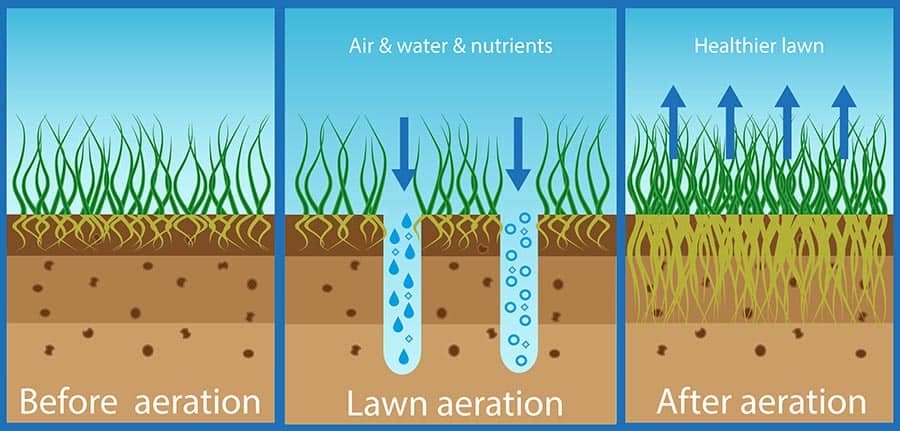Anyone who has a lawn will tell you making your lawn lush, green, and beautiful is not as easy as it looks. And if the soil in your area has a lot of clay, it may be even harder to get a beautiful lawn. You’ve heard of aeration, but how does it work to help your yard look good?
After walking on a lawn for a while, the soil underneath can get very compacted. The compaction can crush the grasses’ roots, making it difficult for them to absorb moisture, atmospheric gases, water, or nutrients. It’s why we need to aerate the lawn.
Lawn aeration works by perforating the soil to below grass root depth. The perforations allow air, moisture, and nutrients to add deep into the ground for easy root uptake.
Lawn aeration creates passageways for air and liquid to travel down into the soil’s root layers several inches down. It helps alleviate the effects of soil compaction, giving new areas for the grasses roots to grow.

Does Lawn Aeration Help?
If you’ve ever tried to do lawn aeration manually, then you’ll know that it’s an awful lot of work. Even using a machine, it’s still an entire process that needs completion on your lawn from time to time.
But I see it is not a process that is required very often compared to something like mowing the lawn. Many people wonder if lawn aeration helps. Well, I’m here to provide the answer to that question by looking at all the different angles of this thing called lawn aeration. Let’s dive in.
Lawn aeration is essential in soils containing a large percentage of clay. When the soil has a large amount of clay proportionately mixed in with sand, organic debris, and other ingredients, the clay allows the soil compaction to form a tight, almost water-tight seal.
When this compaction occurs in the soil underneath, it is difficult for roots to grow and take up nutrients and much-needed carbon dioxide easily. Also, the compression can stop water from penetrating deep into the soil.
Without aeration, roots can be choked and starved of nutrients and gas. However, lawn aeration is unnecessary and may not help in light soil cases that do not need aeration.
Related Articles:
Lawn Aerator Vs. Tiller – Lawn And Garden Tools Explained
Demo: How to Aerate Your Lawn with a Pitchfork
Can You Aerate the Lawn When It’s Wet?
Can You Walk on the Lawn After Aeration?
How Long Does It Take For Aeration To Work?
Depending on the type of soil, aerating the lawn can take anywhere from 1 to 3 weeks to start to work noticeably. However, it also relies on the definition of the success of the aeration project.
For example, if overseeding after aeration is a part of the maintenance, one will be looking for healthy new growth to determine the aeration procedure’s success. As this will depend on an adequately managed watering program, there is more to judging the aeration process’s success than merely putting a time to how long it may or may not appear to show effect.
What Is The Best Time For Aeration?
They say that grass is grass, but there are many different types of grass used in lawns at the end of the day. And every kind of grass has its own best time of year for aeration to occur.
Best Time For Aeration: Cool Season Grasses
For the cooler season grass such as bluegrass, aeration can happen in the spring or fall during cooler times. If aerating in the fall, it should be no later than about four weeks before a frost. Similarly, if aerating in the spring, completion should occur after no more fear of Frost reoccurrence.
These cooler seasoned grasses should not face aeration in the hot summer months.
Best Time For Aeration: Warm Season Grasses
When it comes to the warm-season grasses such as Bermuda grass, the best time for aeration to occur is mid-spring to early summer. It shouldn’t be too cold out, or the grass may suffer. Similarly, it should not be too hot and dry out, or it can cause a soil drought in your lawn.
Lawn aeration should occur at least once per year for a healthy and vibrant lawn.
Should I Mow Before I Aerate My Lawn?
Mowing the lawn directly before and aeration process can be mildly harmful to the grass. However, it should not be a primary concern and prevent you from completing the aeration procedure.
As a general rule, if one mows the lawn one week before and two weeks after aeration, it seems to provide reasonably relevant results.
What Do You Do After You Aerate Your Lawn?
After lawn aeration, nothing more than watering should take place for the first 24 hours. However, if re-seeding or overseeding is to face success after aeration, it can find completion immediately.
What you want to avoid immediately following narration is fertilizing the lawn. As you have just opened up fresh new channels directly to the grasses roots, fertilizing right after aerating can cause root shock. Give it a day for the best results.
After aerating the lawn, it is essential to ensure that the lawn gets enough moisture to prevent drying out of the soil. Therefore watering the yard within 24 hours of aerating is a good idea.
As a general rule for seeding, I like to leave it for 24 hours after aerating as many seeds also come with fertilizer. This rest time following aeration allows the roots a chance to toughen up before being exposed to things like fertilizers.
How Long After Aeration Can I Mow?
If you’ve just aerated your lawn, then there are two schools of thought relating to when you should next mow the grass.
- If an overseeding procedure does not follow the aeration process, mowing the lawn immediately after aeration is okay.
- If overseeding is following the aeration process, then mowing should not occur for 2 to 4 weeks. It will allow the new growth time to grow roots and strengthen before the mower’s powerful suction potentially sucks up seed and damages new growth.
If re-seeding or overseeding is not part of your planned lawn maintenance, then mowing directly after aeration can help break down the plugs left behind from the aeration process. The lawnmower’s blades commonly suck up the plugs, helping to disintegrate them and disperse them back into the soil.
How Long After Aeration Can I Water?
Following a lawn aeration maintenance procedure, one should water the lawn shortly after. Due to the new gas exchange potential with the deeper soil post aeration, if watering is neglected, the aeration can cause the soil to dry out.
Watering post aeration ought to be managed for at least four weeks after the aeration process. Because of the newly-created channels for gas exchange to occur deeper in the soil, there is a much higher likelihood of drying out the soil and causing damage in that respect to your lawn and grass. For this reason, keeping an eye on the lawn’s moisture level after aeration is critical to a successful lawn maintenance program.
How Often Should I Aerate My Lawn?
Aerating the lawn should be done a minimum of once per year. However, that isn’t to say that you can’t aerate your lawn more than once. However, one ought to note what type of grass you have and the best time of year to do the aerating.
Can You Aerate Too Much?
As mentioned, aeration should only occur in specific times of the year and weather conditions depending upon the type of grass you have on your lawn.
If you aerate your lawn repeatedly and regularly, it can be too much and damage the turf. Aeration at the wrong time of year or in the unsuitable environmental conditions can exaggerate lawn damage from heat, drought and even cause the death of large patches of grass.
Similarly, over-aeration during rainy periods can cause root drowning if the soil does not drain well. Following a simple rule of annual or bi-annual aeration is a common and successful tactic.
Should I Pick Up Plugs After Aerating?
When you’ve completed aerating, you’ll notice a whole bunch of little plugs laying all over the place. That is, assuming you are using the more effective core aerating rather than spike aerating.
Likely you will want to rake these plugs up because of how they first appear. Consider resisting this temptation, though, as these little plugs take very little time to decompose and return to nutrients to your lawn.
If you don’t like the look of them, you can always get your sprinkler out because, with a bit of water, those plugs will help disintegrate in a matter of days.

